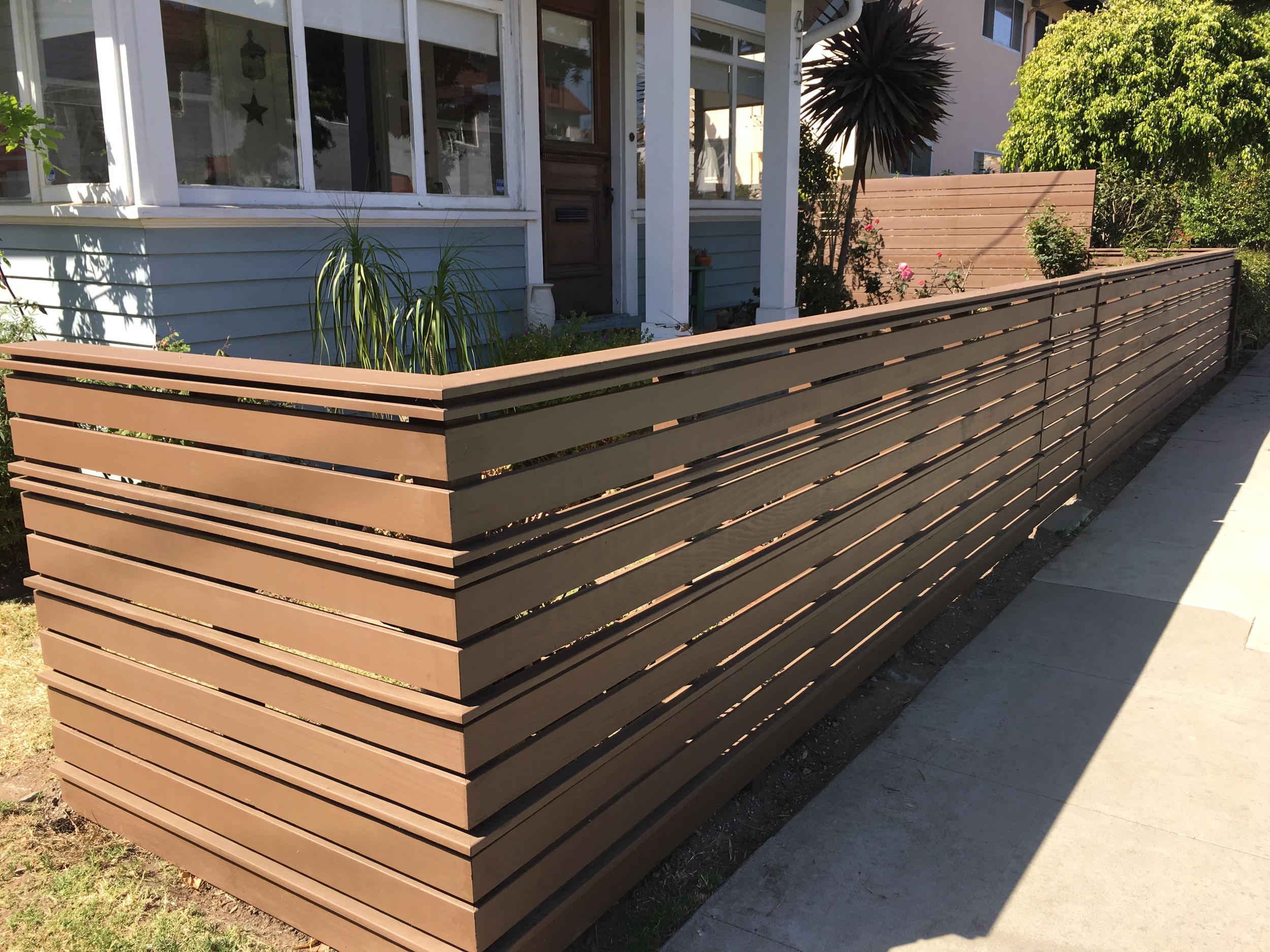Choosing the perfect fence for your front yard is a significant decision that impacts both the aesthetics and functionality of your property. A well-chosen front yard fence not only enhances the curb appeal of your home but also provides security, privacy, and defines property boundaries. With numerous styles, materials, and designs available, it can be challenging to determine the best option for your needs. Understanding the key factors to consider can help simplify this process and ensure you make an informed decision.
By carefully evaluating these elements, you can select a front yard fence that perfectly balances beauty, practicality, and longevity, ultimately adding value and charm to your home. In this blog today, we will explore the seven essential factors to consider when choosing a front yard fence to help you make the best choice for your property.
The Importance of the Front Yard Fence
 The front yard fence plays a crucial role in enhancing the overall appearance and functionality of your property. One of its primary benefits is boosting curb appeal. A well-designed fence complements the architectural style of your home and landscaping, creating a cohesive and attractive look that can increase property value. It serves as a welcoming feature that defines the boundaries of your space while adding a sense of order and structure. Additionally, a front yard fence can be customized with various materials, colors, and designs to reflect your personal taste and the character of your neighborhood, making your home stand out in a positive way.
The front yard fence plays a crucial role in enhancing the overall appearance and functionality of your property. One of its primary benefits is boosting curb appeal. A well-designed fence complements the architectural style of your home and landscaping, creating a cohesive and attractive look that can increase property value. It serves as a welcoming feature that defines the boundaries of your space while adding a sense of order and structure. Additionally, a front yard fence can be customized with various materials, colors, and designs to reflect your personal taste and the character of your neighborhood, making your home stand out in a positive way.
Beyond aesthetics, a front yard fence also offers practical advantages. It provides an added layer of security by acting as a physical barrier that deters trespassers and enhances privacy. For families with children or pets, a front yard fence is essential in ensuring a safe play area where kids and animals can roam freely without the risk of wandering into the street. Furthermore, it can serve as a sound barrier, reducing noise from nearby roads and creating a more peaceful outdoor environment. By combining visual appeal with functional benefits, the front yard fence is a vital element in making your property more secure, private, and enjoyable.
7 Factors to Consider When Choosing Front Yard Fence
When selecting a front yard fence, it’s important to consider various factors to ensure it meets your needs and enhances your property’s appeal.
Purpose

When choosing a front yard fence, one of the most critical factors to consider is the purpose it will serve. Understanding why you need a fence helps determine the most suitable type, material, and design. For instance, if your primary goal is to enhance security, you might opt for a tall, sturdy fence made of metal or composite materials that can deter intruders. These types of fences can include features like spear tops or lattice panels that make climbing difficult, thereby providing an effective barrier against unauthorized access.
On the other hand, if privacy is your main concern, you may prefer a solid panel fence or a fence with closely spaced slats that shield your yard from prying eyes. Privacy fences can also create a quiet, serene environment, reducing noise from the street and giving you a secluded outdoor space. Aesthetics and boundary definition are also important purposes for installing a front yard fence. A decorative fence can significantly enhance your home’s curb appeal, giving it a polished and well-maintained look that complements your property’s architectural style.
Architectural Style

The fence should complement and enhance the overall aesthetic of your property, creating a cohesive and harmonious look. For instance, a traditional picket fence with its classic, charming appeal is an ideal match for a colonial or cottage-style home. Its simple, yet elegant design underscores the quaintness and historical charm of these architectural styles, adding to the home’s overall curb appeal.
In contrast, contemporary homes often benefit from sleek, minimalist fence designs that emphasize clean lines and modern materials. A horizontal slat fence made of metal or composite materials can provide a stylish and understated barrier that aligns with the home’s modern aesthetic. Similarly, a wrought iron fence with intricate detailing can beautifully complement a Victorian-style home, highlighting its ornate and sophisticated features. By aligning the fence design with your home’s architectural style, you not only enhance the visual appeal of your property but also create a unified look that adds value and character to your home.
Material Durability

Material durability is a crucial factor to consider when choosing a front yard fence, as it directly impacts the fence’s longevity, maintenance needs, and overall cost-effectiveness. Different materials offer varying levels of durability, each suited to specific environmental conditions and aesthetic preferences.
- Wood is a popular choice for its natural beauty and versatility, but it requires regular maintenance to prevent rot, insect damage, and weathering. Pressure-treated wood and cedar are more durable options within this category, offering better resistance to decay and pests, but they still require periodic sealing or staining to maintain their appearance and strength.
- Metal fences, such as those made from steel or aluminum, provide excellent durability with minimal maintenance. Steel fences are incredibly strong and can withstand significant impacts, making them ideal for security purposes. However, they are susceptible to rust if not properly coated and maintained. Aluminum fences, on the other hand, are rust-resistant and require very little upkeep, making them a great option for humid or coastal environments.
- Vinyl and composite fences offer another durable alternative, combining the look of wood with the low maintenance benefits of plastic. These materials are resistant to rot, insects, and weathering, and they come in various styles and colors to match any home design.
By choosing a material that balances durability with your maintenance preferences and aesthetic goals, you can ensure your front yard fence remains functional and attractive for years to come. This thoughtful selection not only protects your investment but also enhances the overall value and appeal of your property.
Maintenance

When selecting a front yard fence, maintenance is a critical consideration that influences the long-term appearance, durability, and overall cost of your investment. Different fencing materials have varying maintenance requirements, which can impact your decision based on the amount of time and effort you are willing to commit to upkeep.
- Wood fences, while beautiful and versatile, require regular staining or painting every few years to protect against moisture, UV damage, and insect infestations. Additionally, wood fences need periodic inspections to identify and repair any signs of rot or damage promptly.
- Vinyl fences are resistant to rot, insects, and weather damage, requiring only occasional cleaning with soap and water to remove dirt and mildew.
- Metal fences, particularly those made from aluminum, are also low-maintenance, needing only periodic cleaning and rust prevention touch-ups for steel versions.
- Composite fences combine the aesthetics of wood with the durability of synthetic materials, offering resistance to rot, insects, and weathering without the need for painting or staining.
These materials maintain their appearance with minimal effort, making them an excellent choice for homeowners seeking a long-lasting, low-maintenance fencing solution.
Budget
The cost of a fence can vary widely depending on factors such as the chosen material, fence height and length, installation complexity, and additional features like gates or decorative elements. For example, wood fences are generally more affordable initially but may require ongoing maintenance expenses, such as staining or repairs. On the other hand, vinyl and composite fences may have a higher upfront cost but often offer long-term savings due to their minimal maintenance requirements. Metal fences, such as aluminum or steel, can also vary in price based on their durability and customization options.
By establishing a clear budget and considering both initial costs and long-term maintenance expenses, homeowners can select a front yard fence that not only meets their aesthetic preferences and functional needs but also fits comfortably within their financial plan.
Local Regulations

Before installing a front yard fence, it’s essential to research and understand local regulations and zoning ordinances that govern fence height, materials, and placement. Many municipalities have specific guidelines regarding fence construction to ensure safety, neighborhood aesthetics, and property boundaries. These regulations may dictate the maximum height allowed for fences in front yards, the type of materials permitted, setback requirements from sidewalks and property lines, and even the need for permits or approvals before installation.
By adhering to local regulations, homeowners can avoid fines, disputes with neighbors, and the potential need to modify or remove non-compliant fences in the future. Consulting with local authorities or a professional fence contractor can provide clarity on regulations and ensure that the chosen fence design meets all necessary requirements.
Design Options

Choosing the right design for your front yard fence is essential as it significantly contributes to the overall appearance and functionality of your property. Whether you opt for a classic picket fence that exudes charm and openness or a modern horizontal slat fence that offers a sleek and contemporary aesthetic, each design option brings its own unique blend of style, privacy, and architectural enhancement. It’s crucial to consider how the chosen design will complement your home’s exterior, reflect your personal taste, and fulfill practical needs such as security and privacy. By selecting a well-suited design, you can enhance the curb appeal of your property while creating a welcoming and visually appealing boundary for your front yard.
Conclusion
Choosing the ideal front yard fence involves careful consideration of various factors, from design and materials to maintenance and local regulations. By prioritizing these aspects, homeowners can create a fence that not only enhances the aesthetic appeal of their property but also provides practical benefits such as security, privacy, and defining property boundaries. Whether opting for a traditional picket fence that adds charm or a modern, low-maintenance vinyl fence that offers durability, the right choice ensures that the front yard fence becomes an integral part of a welcoming and well-maintained home exterior.
Ultimately, a thoughtfully selected fence enhances both the functionality and beauty of the property, contributing to a secure and appealing environment for homeowners and visitors alike.






